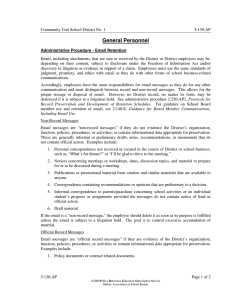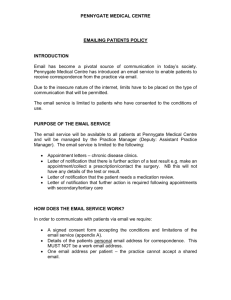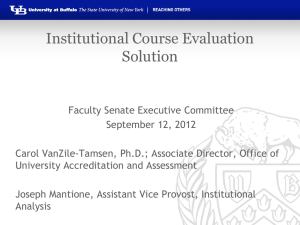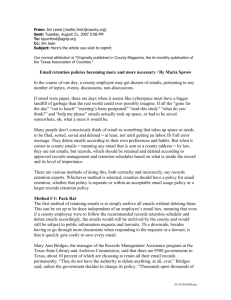What is a "Public Record" under the Local Records Act?
advertisement
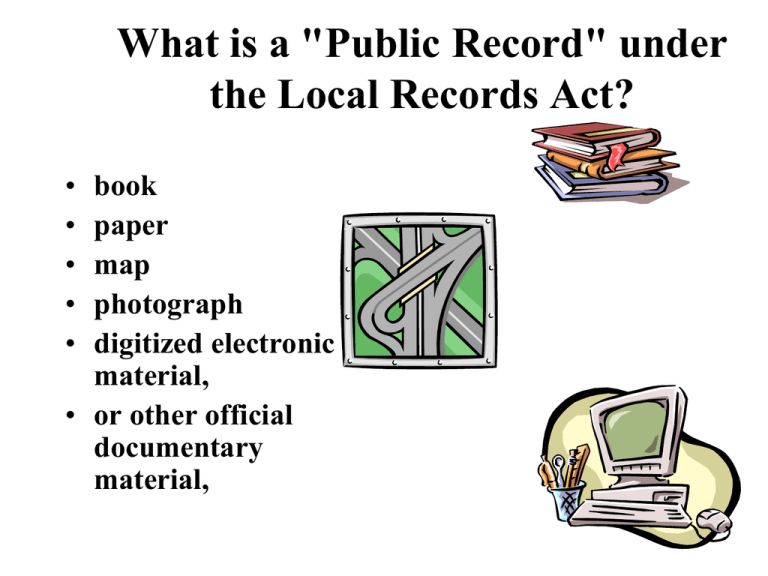
What is a "Public Record" under the Local Records Act? • • • • • book paper map photograph digitized electronic material, • or other official documentary material, Public Records • regardless of physical form or characteristics, • made, produced, executed or received by any agency or officer pursuant to law or in connection with the transaction of public business and • preserved or appropriate for preservation by such agency or officer, or any successor thereof, • as evidence of the organization, function, policies, decisions, procedures, or other activities thereof, or because of the informational data contained therein. What is a public record under the “Local Records Act”? • Basically records that fall under the “Local Records Act” are every type of record you receive or generate in the course of business including electronic records. Electronic Records • When we talk about electronic records such as instant messages one of the things that it may be difficult to determine is when does the record begin and when does it end? • On-line meetings with multiple participants, who is responsible for saving the records of these types of transactions? • Had you even thought about these being records before? Non-Records • Library and museum material made or acquired and preserved solely for reference or exhibition purposes, extra copies of documents preserved only for convenience of reference, and stocks of publications and of processed documents are not included within the definition of a public record. (Source: P.A. 89-272, eff. 8-10-95.) Non-Record Materials • While you do not need the permission of the LRC to dispose of extra copies of materials, you need to be careful when disposing of materials such as draft copies of records which might contain personal identification data because of identity theft issues. Non-Record Materials • An example of a non-record are the books, magazines, and papers that are part of the collections of a library. • With regard to libraries such items as computer sign-in sheets, book check out records, etc. are records under the “Local Records Act” and must be retained according to the retentions set by the Local Records Commission. • Confidentiality issues should not be confused with retention issues. Non-Record Materials • Some other examples of non-records are junk emails, Christmas Party announcements, business cards and brochures from salesmen Are faxes, videos, emails, and instant messages records, etc.? • Yes, depending on the information contained in the fax, email, or instant message or the information recorded on the dvd, cd, video, or cassette tape, etc. • We determine if it is a record by the information contained therein, not by the media the information is stored on. • If the information fits the aforementioned definition, it is a public record subject to the provisions of the “Local Records Act” regardless of the media in which the data is maintained. Video Recordings • In some municipalities the Police Departments have video cameras on top of utility poles, those video tapes sometimes document the commission of a crime, sometimes they capture what happened in a traffic accident. • Other examples of video recordings that could be considered records are school bus videos, booking videos, videos of public body meetings, squad car videos. Email Records • Many of us are actually sending out and receiving more emails in our office than we are preparing typed paper correspondence. • If we receive the email or send the email as part of our job duties it is a record. • Even inner-office emails can be records. Email Correspondence • If you are a supervisor and you direct an employee to complete a task. • That email might later be needed if there is a disciplinary action taken involving that employee not completing the task as directed or if you are the employee, your response might indicate that you did complete the task. • Email read receipts prove whether or not someone received and read a particular email. Electronic Records • Sent and received emails which relate to negotiating a contract with a vendor are correspondence. • These would generally be considered part of a contract file and not part of a general correspondence file.
